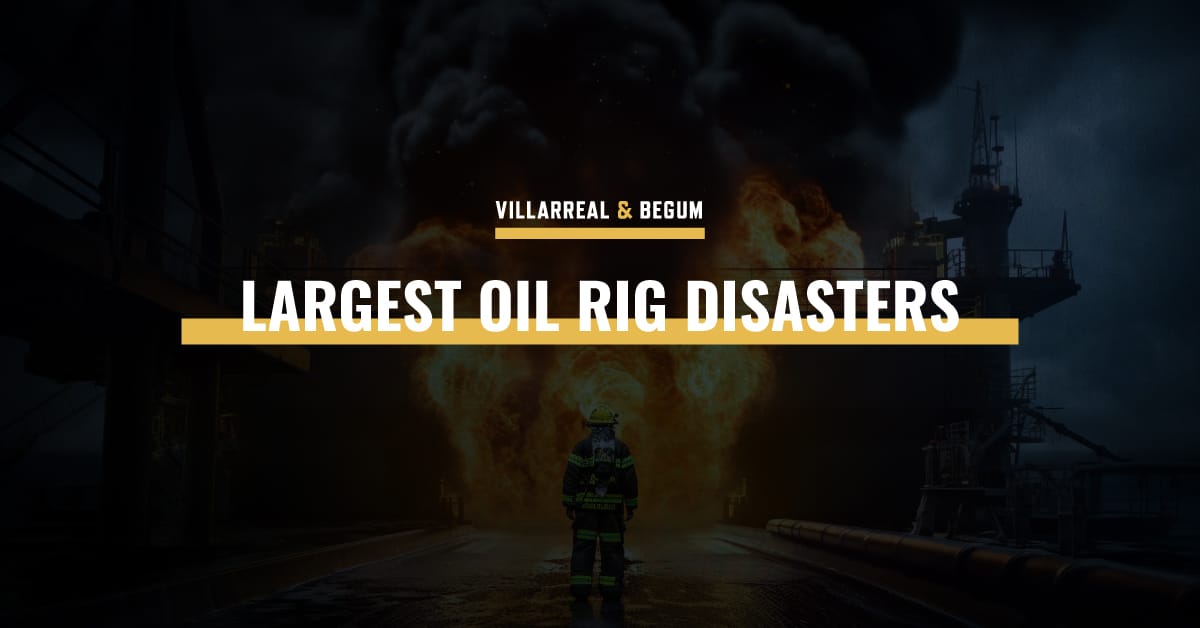Oil rig disasters are catastrophic events that result in the uncontrolled release of oil and gas from drilling and production facilities. These incidents have significant implications for both human safety and the environment, and understanding their impact is crucial because it sheds light on the devastating consequences of industrial accidents.
In this blog, we’ll take an in-depth look at 15 of the largest oil rig disasters in history. These incidents serve as stark reminders of the risks associated with offshore drilling and the importance of safety measures. By examining these disasters, we can gain insight into the human injuries, environmental damage, and lessons learned from these tragic events.
Early Oil Rig Disasters
In the early days of oil exploration, things didn’t always go as planned. Mistakes, accidents, and unforeseen circumstances led to some of the first oil rig disasters. These incidents, though less technologically advanced than modern ones, had their own set of challenges and consequences. In this section, we’ll take a straightforward look at some of the early oil rig disasters that marked the industry’s history.
The Lakeview Gusher (1910)
The Lakeview Gusher of 1910 marked one of the most colossal oil disasters in California’s history. Situated in the Midway-Sunset Oil Field near Bakersfield, this uncontrolled release of oil was more akin to a relentless river than a conventional rig explosion.
On March 14, 1910, an uncontrollable blowout occurred during routine drilling operations at Lakeview No. 1. Caused by a combination of high-pressure gas and oil reserves deep underground, it blasted oil and natural gas into the sky, reaching heights of up to 200 feet. The eruption continued unabated for 18 months, spewing millions of barrels of oil into the environment.
Beyond its environmental toll, The Lakeview Gusher had a profound impact on the people in the vicinity. The fumes from the uncontrolled blowout posed serious health risks to those nearby, leading to respiratory issues and other health problems. Moreover, the economic devastation caused by the disaster affected the livelihoods of countless individuals and businesses connected to the region’s agriculture and oil industries.
The Santa Barbara Oil Spill (1969)
The Santa Barbara Oil Spill began on January 28, 1969, when an oil platform experienced a blowout, leading to the uncontrolled release of oil and natural gas into the waters of the Santa Barbara Channel. The blowout occurred during drilling operations, and efforts to contain it were initially unsuccessful.
The environmental impact of this disaster was devastating. Over three million gallons of oil spewed into the ocean, coating beaches, shoreline habitats, and marine life with a thick layer of crude oil. Birds, fish, and marine mammals were particularly affected, with many being killed or suffering long-term harm. The spill had a lasting impact on the region’s fragile coastal ecosystems and biodiversity.
The Santa Barbara Oil Spill also caused severe economic losses to the local fishing and tourism industries, as well as property damage for coastal residents. Furthermore, the health of individuals who participated in cleanup efforts or lived in the affected areas was jeopardized due to exposure to toxic chemicals present in the spilled oil.
Bravo Blowout (1975)
The Bravo Blowout of 1975 was a significant offshore drilling incident that occurred in the Ekofisk oil field, located in the North Sea. It began on April 22, 1975, during drilling operations when high-pressure gas was unexpectedly encountered, leading to the uncontrolled release of oil and gas from the well. Despite immediate efforts to control the blowout, including the use of blowout preventers and drilling mud, initial attempts were unsuccessful.
The incident had notable consequences, including the release of a substantial amount of oil into the North Sea, resulting in a visible oil slick. This oil spill had adverse effects on marine life in the North Sea, with reports of oil-coated seabirds and potential harm to fish and other aquatic species. The Bravo Blowout also raised concerns about safety procedures and equipment reliability in the offshore drilling industry, particularly in the North Sea.
Ekofisk Bravo Blowout (1977)
The Ekofisk Bravo blowout occurred on April 22, 1977, in the Ekofisk oil field located in the North Sea. The incident was a result of technical and operational failures during drilling operations.
The blowout started when a well control valve failed during drilling, allowing the uncontrolled release of oil and gas from the well. Efforts were made to cap the well using relief wells and other means, but they were initially unsuccessful.
The blowout had significant consequences for the environment and the economy. The well released a substantial amount of oil into the North Sea, creating a large oil slick on the surface. However, it also played a pivotal role in driving safety improvements and regulatory changes in the North Sea oil industry to prevent similar incidents in the future.
Ixtoc I Oil Spill (1979)
The Ixtoc I oil spill was triggered by a well blowout that occurred on June 3, 1979, in the Bay of Campeche, Gulf of Mexico. The incident was the result of a series of technical and operational failures during drilling operations by the Mexican state-owned oil company, Pemex.
The blowout began when drilling mud, used to control pressure in the well, failed to prevent the uncontrolled release of oil and gas. This was due to a faulty blowout preventer. Pemex made multiple attempts to cap the well and stop the flow of oil. These efforts included using relief wells and containment devices, but they were initially unsuccessful.
The well released an estimated 10,000 to 30,000 barrels of oil per day into the Gulf of Mexico for nearly nine months. The United States and Mexico collaborated in containment and cleanup efforts, with U.S. experts and equipment being deployed to assist Mexico in managing the spill.
Bohai 2 Oil Rig Disaster (November 1979)
In November 1979, the Bohai 2 jack-up rig sank in the Gulf of Bohai, off the coast of China. As the rig was being towed, an unexpected storm emerged, subjecting it to fierce winds. Tragically, the ventilator pump of the platform was damaged during the tempest, causing a puncture hole in the deck and extensive flooding. This loss of stability, coupled with the relentless onslaught of severe weather conditions, eventually led to the rig’s catastrophic capsizing.
Unfortunately, the tow boat proved incapable of rescuing the crew members, who lacked proper training in emergency evacuation procedures and the use of lifesaving equipment. It was later discovered that deck equipment had not been correctly stowed prior to towing, contributing to the disaster. Moreover, standard towing procedures for inclement weather conditions were not adhered to, possibly exacerbated by the fact that operating instructions for the Japanese-made rig had not been translated into Chinese until after the incident.
Alexander L. Kielland Platform Disaster (1980)
The Alexander L. Kielland platform disaster occurred on March 27, 1980, in the North Sea off the coast of Norway. This tragic incident involved the sudden and catastrophic collapse of a semi-submersible drilling rig being used as an accommodation platform for oil workers.
The disaster was triggered by extreme weather conditions, including high winds and rough seas, which exerted significant stress on the platform’s structure. As a result of these adverse weather conditions and structural vulnerabilities, the platform tilted, capsized, and ultimately sank, with all 123 crew members on board losing their lives. It remains one of the deadliest offshore drilling incidents in history.
In the wake of the Alexander L. Kielland disaster, extensive changes were implemented in offshore safety regulations and industry practices. These changes focused on improving rig stability and safety features, enhancing emergency response procedures, and introducing stricter safety regulations. The goal was to prevent similar tragedies in the future and ensure the safety of offshore oil workers operating in challenging and potentially hazardous environments.
Ocean Ranger Disaster (1982)
The Ocean Ranger disaster unfolded on February 15, 1982, in the waters off the coast of Newfoundland, Canada. This tragic incident involved the sinking of a semi-submersible drilling rig operated by Mobil Oil Canada.
The disaster occurred during a severe winter storm with hurricane-force winds and high waves, which placed immense stress on the rig’s structure. Despite efforts to maintain stability, the Ocean Ranger suddenly capsized and sank, killing all 84 crew members on board. This loss made it one of the deadliest offshore drilling incidents in history.
In response to the Ocean Ranger disaster, significant changes were implemented in offshore safety regulations and industry practices. They included enhancing rig stability and safety features, conducting more rigorous emergency response drills, and introducing stricter safety regulations. The goal was to prevent similar tragedies and ensure the safety of offshore oil workers facing challenging and potentially hazardous conditions.
Malacca Sultan Blowout (1982)
The Malacca Sultan blowout of 1982 occurred in the Malacca Strait, near Malaysia. It commenced when drilling operations encountered unexpected high-pressure gas and oil reservoirs beneath the seabed. Despite immediate efforts to control the situation, such as deploying blowout preventers and other safety measures, the well experienced an uncontrolled release of oil and gas.
The environmental and safety implications of the Malacca Sultan blowout were substantial. The incident led to the release of a considerable volume of oil into the Malacca Strait, resulting in the formation of an oil slick on the sea’s surface. This oil spill had detrimental effects on marine life, coastal ecosystems, and the livelihoods of local communities.
Response efforts were promptly initiated to mitigate the damage. Containment and cleanup operations were launched to corral and remove the spilled oil from the sea surface. Additionally, environmental assessments were conducted to evaluate the extent of the environmental damage caused by the blowout.
The Ivar Aasen Blowout (1985)
The Ivar Aasen blowout of 1985 was a significant offshore drilling incident that occurred in the Norwegian North Sea. This event unfolded when unexpectedly high-pressure gas and oil reservoirs were encountered beneath the seabed. Unfortunately, the blowout preventer, a critical safety device, failed to function as intended, resulting in the uncontrolled release of oil and gas from the well.
The incident had environmental consequences, leading to a considerable volume of oil being released into the North Sea and creating an oil slick on the sea’s surface. This spill had adverse effects on marine life and coastal ecosystems in the North Sea, causing harm to fish, seabirds, and other wildlife. Moreover, it raised concerns about the effectiveness of safety equipment and procedures in offshore drilling operations.
In response, containment and recovery operations were initiated to corral and remove the spilled oil while assessments were conducted to evaluate the extent of environmental damage. The incident also prompted improvements in offshore drilling safety, including a reevaluation of safety protocols and equipment to enhance well control measures and the functionality of blowout preventers.
Ocean Odyssey Blowout (1988)
The Ocean Odyssey blowout of September 1988 unfolded during drilling operations on the Ocean Odyssey drilling rig and had several significant repercussions. It was triggered when drilling operations unexpectedly encountered high-pressure gas and oil reserves beneath the seafloor. Despite immediate efforts to control the situation, including the activation of safety mechanisms like blowout preventers, the well continued to release oil and gas uncontrollably.
The incident resulted in the release of a substantial volume of oil into the Gulf of Mexico, leading to the formation of an oil slick on the sea’s surface. This spill had adverse effects on marine life and coastal ecosystems in the Gulf, causing harm to fish, seabirds, and other wildlife. Moreover, the incident raised concerns within the industry about the effectiveness of safety equipment and procedures in offshore drilling operations, emphasizing the need for enhanced safety measures.
Efforts were swiftly initiated to mitigate the damage caused by the blowout. Containment and cleanup operations were launched to corral and remove the spilled oil from the sea surface. Environmental assessments were conducted to assess the extent of the damage and guide subsequent cleanup efforts.
Piper Alpha Disaster (1988)
The Piper Alpha Disaster, one of the deadliest oil rig incidents in history, occurred on July 6, 1988, in the North Sea. It began with a gas leak and culminated in a series of explosions and fires on the Piper Alpha platform, operated by Occidental Petroleum. The disaster unfolded due to a combination of factors, including safety lapses and communication failures.
The Piper Alpha Disaster resulted in the tragic loss of 167 lives, making it one of the deadliest offshore oil rig incidents. Beyond the human toll, the environmental impact was comparatively limited, as most of the oil on the platform burned off during the inferno. However, the incident had severe psychological and emotional consequences for the survivors and the families of the victims.
The disaster underscored the importance of rigorous safety protocols. It led to a renewed commitment to safety in offshore operations around the world, with companies implementing enhanced safety procedures and worker training.
Usumacinta Jack-up Disaster (October 2007)
On October 23, 2007, a tragic collision between a drilling rig and a platform in the Bay of Campeche, Gulf of Mexico, resulted in the loss of 22 lives. The incident unfolded during drilling operations contracted by PEMEX, Mexico’s state-owned oil company.
PEMEX had engaged the Usumacinta Jack-up rig to be positioned alongside the Kab-101 platform to complete drilling activities for the Kab-103 well. However, the operation was met with unforeseen challenges. A severe storm emerged, bringing winds gusting at speeds of up to 130 km/h and waves reaching heights of eight meters.
The Usumacinta rig broke free from its moorings and its cantilever deck struck the production valve tree on the Kab-101 platform, leading to the release of oil and gas. The leaked oil and gas subsequently ignited, compelling the 73 crew members to initiate an evacuation using two lifeboats.
Tragically, one of the lifeboats began filling with water and eventually capsized. The other boat, while surviving the initial ordeal, overturned as well. It washed ashore upside-down the following day with 12 survivors clinging to it. In total, 21 people lost their lives, and one worker went missing during the subsequent rescue operation.
Montara Oil Spill (2009)
The Montara well blowout happened in August 2009 in the Timor Sea, off the coast of Australia. It was a significant offshore drilling incident that occurred during the drilling of the Montara well, which was operated by PTTEP Australasia.
The blowout resulted in the release of an estimated 4,200 barrels of crude oil per day into the Timor Sea for over two months. This oil formed large surface slicks that spread across a wide area, affecting marine life and coastal areas. Fishing grounds in the affected area were closed due to the contamination, causing economic hardship for local fishermen and communities dependent on the seafood industry.
The blowout was eventually capped after more than two months, halting the release of oil and gas from the well. Acknowledging the economic losses incurred due to the spill, PTTEP Australasia provided compensation to affected communities and industries.
Deepwater Horizon (2010)
The Deepwater Horizon disaster, also known as the BP oil spill, unfolded on April 20, 2010, in the Gulf of Mexico. It began with a blowout during drilling operations on the Deepwater Horizon drilling rig, which was operated by Transocean and leased by BP. The blowout resulted in a catastrophic explosion and fire on the rig, leading to the loss of 11 lives. The rig eventually sank two days later, leaving the wellhead open on the seabed.
The environmental impact of the Deepwater Horizon disaster was staggering. Over the course of 87 days, millions of barrels of crude oil spewed into the Gulf of Mexico. This massive oil discharge severely affected marine life, coastal ecosystems, and the livelihoods of communities along the Gulf Coast.
BP faced substantial cleanup costs and established a $20 billion trust fund to compensate individuals and businesses affected by the spill. The disaster also led to increased scrutiny and regulatory reforms in the offshore drilling industry, including more stringent safety standards and oversight.
Oil Rigs Can Be Dangerous Places to Work
Oil rigs, both offshore and onshore, are inherently hazardous workplaces. The incidents and disasters discussed earlier highlight the significant risks involved in extracting oil and gas from beneath the Earth’s surface, particularly in offshore environments. Despite advances in technology and safety measures, ongoing challenges persist in offshore drilling safety.
While one of the primary challenges is the unpredictable nature of the marine environment, human factors also play a critical role in drilling safety. Proper training and adherence to safety protocols are essential, yet accidents and injuries continue to occur due to human error. The Usumacinta Jack-up disaster, for instance, underscored the importance of crew members’ training in emergency evacuation procedures and the use of lifesaving equipment. The history of offshore drilling disasters serves as a reminder that safety must always be a top priority.
Speak to an Oil Rig Injury Lawyer Today
All of these oil rig disasters have left enduring marks on the offshore drilling industry, emphasizing the critical importance of safety measures and vigilance in this inherently risky field of work. Those tragic incidents prove the need for continuous improvement and strict safety protocols to keep workers safe and prevent environmental damage.
If you or a loved one has been affected by an oil rig disaster and suffered injuries or losses, it’s essential to seek the appropriate legal guidance and support of an experienced oil drilling accident attorney. The Villarreal & Begum, LAW GUNS, are here to provide assistance and advocate for your rights. We have years of experience handling oil ring injury cases and will fight for the compensation you deserve. To schedule a free initial consultation, call (512) 800-0000 or contact us online today.
Related:
San Antonio Plant and Refinery Accident Lawyers
San Antonio Plant and Refinery Explosions Lawyers
Filing a Lawsuit After an Oil Field or Offshore Accident
Longshore Workers Injury Lawyers

Alex has tried over 50 trials to verdict and tried or settled over five hundred million dollars in cases. Alexander Begum is a founding shareholder of the Villareal & Begum Law Firm. Born and raised in Texas.





